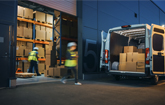BOSTON, June 9, 2022 /PRNewswire/ -- A service robot refers to a machine/robot that performs useful tasks excluding industrial automation applications. As a broad definition, service robots can be utilized to automate a wide spectrum of industries ranging from logistics and delivery, cleaning and disinfection, to socializing, agriculture, underwater exploration, and food service. Over the past decade, service robots have gained significant momentum with a double-digit growth rate. Here, IDTechEx outlines two of the most exciting applications in the service robotics world and analyzes the key technological highlights. As an example, the market size for logistics and delivery robots is forecast to be 9 times larger in 2032 than it was in 2021. These innovations span from advanced sensors, covering their advantages and drawbacks, to how they are utilized in logistics service robots and cleaning and disinfection service robots.
Service robots for logistics and delivery
Driven by COVID and the trend for contactless delivery, service robots for logistics and delivery, specifically, Autonomous Mobile Robots (AMR) and Autonomous Guided Vehicles (AGV) have seen much greater adoption thanks to their flexibility, cost-effectiveness, scalability, and efficiency. Most of these robots operate in well-controlled indoor environments (e.g., warehouses, factories, etc.), although more and more are being applied in outdoor environments with public traffic (i.e., last-mile delivery). To achieve a high level of autonomous mobility with limited human supervision and maintain a high safety level, a suite of sensors needs to be incorporated to enable the environmental perception ability of delivery robots. Typical sensors for environment awareness include cameras, Radar, and LiDAR. Whilst cameras have the highest affordability, resolution, and object classification, they have poor performance in a low-visibility environment (e.g., at night). By contrast, radar systems are immune to low light conditions and are able to accurately measure range and velocity, although they are more expensive than cameras. LiDAR presents the best performance for object classification in bad weather/at night but is significantly more expensive than radar and cameras. Therefore, depending on the specific applications, different sensory systems should be used. IDTechEx's latest report on "Service Robots 2022-2032: Technologies, Players & Markets" and "Mobile Robotics in Logistics, Warehousing and Delivery 2022-2042" provides a detailed comparison of these sensors in several service robotics applications.
Service robots for cleaning and disinfection
Driven by the COVID pandemic, cleaning and disinfection service robots have become more popular. Cleaning and disinfection robots refer to robots with the capability of disinfecting and cleaning their surrounding environments, regardless of how it is achieved. It is reported by the International Federation of Robotics (IFR) that more than 50 service robot providers developed disinfection robots in response to the hygiene requirements because of COVID.
Similar to delivery robots, cleaning robots are also equipped with sensors including cameras, LiDAR, and radar to achieve autonomous mobility. The end-effectors of cleaning robots are particularly interesting. The method of cleaning and disinfection robots use to sanitize their surrounding environments can be briefly segmented into two categories including mechanical cleaning (e.g., wiping and scrubbing) and non-mechanical cleaning (e.g., ultra-violet (UV) lights, spraying disinfectants, etc.). The fundamental difference between mechanical and non-mechanical cleaning methods is if microorganisms are killed or not. Mechanical methods are designed to physically remove the dirt or biological materials, whereas non-mechanical approaches are typically based on indirect contact to kill biological materials. As a traditional method, mechanical cleaning is typically less complicated and pricy whereas it could be hard for them to be used on hidden surfaces or corners. By contrast, non-mechanical approaches can mitigate this issue as there is no direct contact between the cleaning module and the target cleaning spot. UV-based irradiation or spraying could be more efficient in reducing microbial contamination than mechanical methods. However, they are usually more expensive compared to mechanical cleaning, which leads to low affordability. Meanwhile, UV- or spraying-based cleaning methods are susceptible to shadowing and distances. For an extensive discussion of the pros and cons of these two methods, the drivers and barriers to their customer adoption, and a comparison of different technologies used, please see the recently released IDTechEx report "Service Robots 2022-2032: Technologies, Players & Markets".
Concluding thoughts
It is clear that both logistics & delivery robots and cleaning & disinfection robots will see an increase in the upcoming decade. For logistics and delivery robots, IDTechEx believes that 2025 is a critical time as we expect the regulations to be eased by then, therefore, the market after 2025 is expected to have faster growth. By contrast, the adoption of cleaning and disinfection robots is seeing a linear increase because cleaning robots have been investigated for many years, and IDTechEx believes that the technologies will not be revolutionary, therefore, the market uptake will be from a steady customer adoption.
Overall, the past couple of years have been exciting for both delivery robots and cleaning robots. The increasing market demand shows great potential for manufacturers and OEMs. IDTechEx's report on "Service Robots 2022-2032: Technologies, Players & Markets" includes emerging technologies, regulations, market analysis, and financial trends of not only delivery and cleaning robots, but also other promising applications within the service robotics sector. IDTechEx believes that service robots will be increasingly adopted in other commercial applications including agriculture, logistics, and others. For each type of robot, a deep dive is taken into each application area along with company examples and a 10-year granular market forecast.
About IDTechEx
IDTechEx guides your strategic business decisions through its Research, Subscription and Consultancy products, helping you profit from emerging technologies. For more information, contact research@IDTechEx.com or visit www.IDTechEx.com.
Images download:
https://www.dropbox.com/sh/auykfx573tiovi8/AACTNOYHmEtTexir10WyTZL4a?dl=0
Media Contact:
Natalie Moreton
Digital Marketing Manager
press@IDTechEx.com
+44(0)1223 812300
Social Media Links:
Twitter: https://www.twitter.com/IDTechEx
LinkedIn: https://www.linkedin.com/company/idtechex/
Facebook: https://www.facebook.com/IDTechExResearch
Photo: https://mma.prnewswire.com/media/1836692/IDTechEx_Logistics.jpg
Logo: https://mma.prnewswire.com/media/478371/IDTechEx_Logo.jpg






Share this article